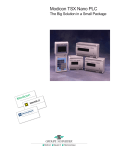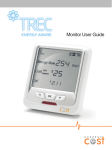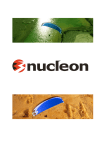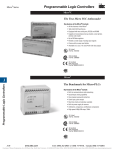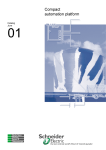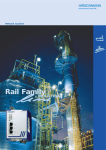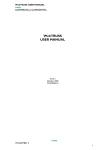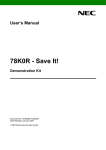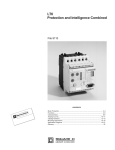Download Modicon Telemecanique Nano programmable controller
Transcript
Modicon Telemecanique Nano programmable controller We do more with electricity. The experience of Schneider in the field of programmable control systems has borne fruit in the Nano, a product benefiting from the latest technological innovations. Extremely compact, it is a cost-effective replacement for traditional solutions. Flexibility is increased and wiring couldn't be simpler. Its features make it suitable to meet requirements ranging from the simplest applications to high-speed and sophisticated uses, in all sectors of activity. 2 Nano Nano programmable controller Extremely compact, broadening the filed of application A PLC which fits anywhere The extremely compact size of the Modicon Telemecanique Nano means that it is equally easy to install both in shallow enclosures and directly within the framework of machines, or in mobile installations. It is easy to mount and can either be clipped onto a DIN rail or screwed vertically or horizontally onto a mounting plate. A flexible and varied range The Nano PLC is easily adapted to a wide variety of applications: ■ 24 VDC or 100-240 VAC supply ■ 24 VDC or 115 VAC inputs ■ 0.5 A transistor (positive or negative logic) or 2 A relay outputs. Since its I/O are compatible with such control system components as two or three-wire proximity sensors, photo-electric cells, or contactors, no interface is needed and setup is simplified. The integrated analog potentiometers on the front panel make it easy to debug and run applications. A competitive alternative The Nano PLC is the competitive alternative to control systems which are created using: ■ industrial relays, combined with control system functions (counters, timers, clock, etc) ■ special purpose electronic or relay-based cards. In many cases, the unit cost of the automated system and its development are significantly reduced, and flexibility is increased. The Nano covers all sectors of activity: – parking lot barriers, automatic doors for controlled access – pump management in water distribution – air conditioning for buildings in service industries – embroidery machines in the textile industry – quality control in manufacturing industries – wrapping and packaging in the food industry – industrial washing machines, vending machines, car wash gantries and service machines – control of doors and lighting in public transport vehicles. 3 10 I/O 16 I/O 20 I/O 24 I/O 26 I/O 32 I/O 34 I/O 40 I/O 48 I/O 9 configurations with just 3 products. 4 Available in three sizes, the Nano provides a “just enough” solution to the requirements of applications with 10 to 48 I/O. A large number of functions (EEPROM memory, battery, real-time clock, potentiometers, etc) are built into the Nano PLC, contributing to stock optimization and thus to costs. The outstanding quality/ performance ratio of the Nano PLC increases the competitiveness of both machines and equipment. Nano programmable controller Cuts unneccessary costs Configurations closely matched to requirements The three sizes of Nano PLC and the ability to connect any two of them together results in extremely flexible modularity of the number of I/O. In addition, the ratio of the number of inputs to outputs ensures that the control system engineer's needs are met without compromise. Nine configurations from 10 to 48 I/O can be created from just three standard products. Stock is thus significantly reduced and competitiveness is thereby increased. An international product A large number of integrated functions Developed in strict adherence with international standards (IEC, EN, etc) and UL/CSA approved, the Nano PLC meets the special requirements of all the main markets in terms of both hardware and software.-It is available worldwide through the international presence of the Schneider Group. The programming tools (FTX 117 terminal and PL7-07 software for PC) as well as the documentation are available in 5 languages, endorsing the international character of the Nano. The Nano includes as standard: – a backup battery for the RAM memory – an EEPROM memory for storing programs – a 24 VDC power supply – adjustment potentiometers. It also has: – a realtime clock – configurable I/O (fast counting, pulse output, etc) – two serial ports for connecting third-party devices. UL 508 - File no. E102542 CSA 22.2 N° 142 File no. LR66809M33 conforms to European LV-and EMC directives Marine classification companies (certification pending) Det Norske Veritas Germanischer Lloyd 5 Ready for use with all the most common applications, the Nano PLC can also be easily adapted to suit the special needs of any application. It is easy to program is Instruction List or Ladder language. User-friendly tools, including a pocket programming terminal and a PC type portable industrial terminal, are readily available to help the user. The Nano PLC is easy to mount on a DIN rail or mounting plate, either vertically or horizontally, or even directly on the framework on the machine. 6 Nano programmable controller User-friendly, simple programming and installation FTX 117, the easyto-use portable terminal The FTX 117 terminal is just as easy to use offline in the design office as on the shopfloor when connected to the PLC. Its large back-lit four-line screen and contextual data entry using a limited number of keys make it particularly user-friendly. Program entry and debugging using Instruction List language are thus easy. An application or its data can be backed up either in the internal memory of the terminal or on a memory card (credit card format) which can be transported and duplicated easily. PL7-07 software for intuitive debugging The diagnostics functions associated with the PL7-07 software considerably reduce application startup and maintenance times. ■ program and data animation ■ possibility of saving lists of variables with their values ■ forcing of I/O ■ troubleshooting guided by cross-references for variables ■ offline programming or connected to the PLC ■ modifications possible in Run ■ detailed documentation and online Help. PL7-07 software: powerful languages for every requirement PL7-07 can be used for programming in Instruction List or Ladder language on a PC. These languages conform to standard IEC 1131-3 and can be mixed and reversed. The instructions for Nano ensure that the user can perform fast programming, save memory space and simplify the coding of complex tasks: ■ processing of words (comparisons, conversions, arithmetic, operations, etc) ■ preprogrammed blocks and functions (counters, drum controllers, registers, etc) ■ Grafcet instructions ■ subroutines and jumps ■ mnemonic programming. A full member of the TSX family PL7-07 software uses the same programming syntax as its big brothers, PL7 Micro and Junior. Specifically designed for Nano, it can be launched under Windows via an icon. In addition, a PL7-07 application can be exported to PL7 Micro and run on a Micro PLC with practically no modification. Protection of applications Several levels of protection are available to the user to ensure the security and integrity of the programs: ■ open access to the program and configuration data (supervisor level) ■ access limited to variables and symbols (operator level) ■ fully restricted program access (protection of expertise). 7 up to 200 m 8 With its short processing time and fast up/down counting functions, the Nano PLC optimizes machine response times. Simply by setting parameters on the integral realtime clock, it controls operations with reference to the day, time, or date of events. HMI terminals can be connected directly via the Nano PLC terminal port, with no need for a special interface. Up to four Nano PLCs can be linked together for distributed applications and up to 31 Nano PLCs can act as Modbus slaves when connected to a Modbus master device. Nano programmable controller Powerful, the answer to all your needs. A PLC designed for high-spleed applications The Nano is designed for processing applications where response time is critical: ■ Scan time is 0.45 ms per 1000 instructions ■ 10 kHz fast counter ■ 1 kHz fast up/down counter ■ User-configurable input filter time, 100 µs minimum ■ Latching inputs, 50 µs minimum ■ Timers with 1 ms precision ■ Pulse outputs 4.9 kHz maximum A-PLC which is open to distributed architectures The capabilities of the Nano PLC meet machine communication requirements and can save wiring costs through closer installation of PLCs to sensors and actuators. Four Nano PLCs can be linked together at a distance of up to 200 m (4-word exchange per PLC). The two RS 485 ports on the Nano enable various point-to-point or multidrop connections to be made: – Uni-Telway master or salve – Modbus slave – ASCII link. An integral realtime clock Applications which include time-based management can easily be created using the realtime clock which is integrated as standard in the Nano PLC. 16 realtime clock blocks can be programmed for daily or monthly operations by simple configuration using the FTX 117 pocket terminal. Date, actual time and measurement of a period of time can all be directly accessed via the program and can be displayed on any dialogue terminal connected to the terminal port. Analog modules Simple control applications requiring processing on one input and/or one output are easy to create by adding modules: – the input module (1 channel, 10 or 12 bits) connects to the fast counter input – the output module (1 channel, 8 bits) connects to the PWM output. 1. Analog input module (0-10V, 4-20mA, -10/+10 V) 2. Analog output module (0-10V, 4-20mA, -10/+10 V) 1. 2. 9 Nano programmable controller Application examples Programming the timer Nano PLCs with 16 and 24 I/O have 16 realtime clocks, for which parameters can be defined. They enable the user to control outputs directly (to open and close electrical circuits) or to perform operations on a user program according to the time (month, day, hour and minute). The Nano PLC provides various programming possibilities, such as time references which can be modified via the operator console or calculated by the program, etc. The Nano PLC also enables events to be date-stamped and time calculations to be performed by the program. The Nano PLC is suitable for control systems managing lighting, heating or sprinkler systems. Analog I/O TSX AEN... and TSX ASN... modules process 1 analog input and 1 analog output re spectively. They are divided into three ranges: 4/20 mA, 0/10 V and -10/+10 V. The input module is connected to the PLC 24 V fast counter input which is configured in frequency mode. The output module uses the pulse width modulation transistor output. The Nano PLC is suitable for simple process control applications (level, temperature, flow rate control, etc) for speed controllers or servo-valves. Fast processing applications The Nano PLCs include as standard certain functions which are simple to use, and can be equally adapted for control systems which require counting capacity or call for short response times: ■ Latching, filtering of 24 V DC inputs with user definable parameters (100 µs; 3 ms or 12 ms). ■ Fast counter (10 kHz max) up/down counter (1 kHz max) with 2 reflex outputs which are controlled directly by the counter function (counting capability 65535 points). Pulse outputs With the PWM and PULSE software functions, the first output from the Nano PLC can be used as: ■ Pulse width modulation output in a predefined frequency (19 kHz to 4.9 kHz) for applications with light or sound intensity control (dimmer function). ■ Pulse generator output (19 kHz to 4.9 kHz) for control of stepper motors. When using these functions, it is necessary to use the transistor output models (which have an unlimited number of operations). 10 Nano programmable controller Communication examples Micro Uni-Telway communication The Nano PLC can communicate with other Uni-Telway devices via its terminal port: speed controller, operator terminals, compact or modular programmable controllers. The capacity of the Nano to transmit and receive messages makes it easy to integrate in distributed architectures. For example in slave mode the Nano can take the initiative in communication and send updated variables to the master (online event processing). Modbus communication The Nano PLC has a RS 485 serial communication port which supports the Modbus protocol. It can process the following requests: ■ read/write bits and words; ■ read the PLC status; ■ set to RUN or STOP; ■ initialize the PLC; Up to 27 Nano PLCs can be linked together over a distance of up to 200 m at userdefinable speeds of 1200 to 19200 bauds. ASCII communication Strichcodeleser The capacity to transmit and receive characters enables the Nano PLC to communicate with a large number of ASCII devices, such as PCs (directly or via modem), printers, barcode readers, etc. The speed and format of the frames are configurable. Connection to the Nano PLC terminal port is via a RS232/485 converter cable powered by the PLC. Modem communication (Modbus protocol) Hauptstandort SPS Master Modbus Master Modbus Slave Modem A PLC with a Modbus master module interrogates Nano PLCs over the remotely switched network. Connected to a modem via an RS 485 link, it generates dialling sequences from remote sites. Each Nano PLC responds to requests by the master, but can also trigger calls by switching a discrete output on the modem. Possible applications: ■ remote system management, ■ remote measurement on isolated sites, ■ water, energy and environmental management. 11 Nano programmable controller Characteristics PLC characteristics Common characteristics Supply voltage Conforms to Temperature Nominal Limit IEC 1131 Power required Ground V eff. Operating Storage Relative humidity V V - °C °C % Input characteristics Nominal input values Logic Input type Voltage Current Sensor supply V mA V - Output characteristics Loads (nominal values) DC loads Voltage Nominal current Tungsten lamp Current V A W A AC loads AC 12 resistive current A AC 15 resistive current A 100 to 240 V AC 24 V DC 100 to 240 - 50/60 Hz 85 to 264 - 47 to 63 Hz Yes 30 V A 2000/50-60 Hz 0 to +60 -25 to +70 5 to 95 24 19.2 to 30 (ripple included) Yes 14 W 2000/50-60 Hz 0 to +60 -25 to +70 5 to 95 115 V AC 24 V DC 110 to 120 10 24/150 mA Conforms to IEC 1131 type 1 24 7 Pos. or neg. depending on wiring Resistive conforms to IEC 1131 type 1 Relays Positive logic protected transistors Negative logic unprotected transistors 24 to 220, 24 DC12 1-24V (0.2x106 ops.) DC13 0.4-24V (1x106 ops.) AC12 1-110/220V (0.2x106 ops.) 0.5-110/220V (2x106 man.) 1-48V (0.5x106 ops.) 2-24V (0.5x106 ops.) AC15 0.22-220V (1x106 ops.) 0.45-24/48/110V (1x106 ops.) 1-24V (0.2x106 ops.) 24 0.5 10 0.625 for U 30 V - common for loads 24 0.5 10 0.625 for U 30 V + common for loads 4-20 mA -10 to + 10 V 4-20 mA -10 to +10 V Analog module characteristics Common characteristics Supply voltage Conformity Temperature Nominal Limit Power consumption Ground IEC 1131 Operating Storage Input characteristics °C °C DC 24 DC 21 to 30 2,5 W 1500 V eff. Yes 0 to +60 -25 to +70 0-10 V Number of channels Resolution Sampling period Output characteristics 1 10 or 12 bits 125 ms for 10 bits/ 500 ms for 12 bits 0-10 V Number of channels Resolution Maximum make time 12 V V 1 8 bits 500 ms (for scale variation 0 to 100%) Nano programmable controller Programming Simple application The example below is for a KM1 starter. After a stop, no restart is permitted for an adjustable time period (KA1). A display, H, is lit continuously while the machine is operating, and flashes during the time period in which a restart is not permitted. Instruction List language (IEC 1131-) Software characteristics PLC characteristics ■ Program memory: 1000 instructions maximum ■ Protected data memory: 256 internal words, 64 constant words, 128 internal bits ■ Scan : normal or periodic ■ Execution time : 0,2 µs for an elementary instruction Instruction List language (IEC 1131-) O KA2 (S6) (I0.0) I KM1 KM1 (I0.1) KA1 KA1 KM1 (O0.0) KA1 (TM0) Instruction List combinational instructions KA2 H1 (O0.0) ■ LD, LDN, LDR, LDF : read the state of a bit, (direct, inverse, rising and falling edges) ST, STN, R, S : update and output (direct, inverse, reset, set) AND, ANDN, ANDR, ANDF : binary logic AND another step (direct, inverse, rising and falling edges) start post-processing OR, ORN, ORR, ORF : binary logic OR (direct, inverse, rising and falling edges) AND (, OR(,) : open and close parentheses (8 possible levels) XOR, XORN, XORR, XORF : exclusive logic OR MPS, MRD, MPP : instructions for processing of coils in parallel MCR, MCS : master relay Instruction List Grafcet instructions • -*-i : step (1 i 62), • =*=i : initial step (1 i 62) , #i : activates the step i, # : deactivates the current step, #Di : deactivates a step i from another step, =*=POST : start post-processing, Xi : bit associated with the step Ladder network 10 contacts with 1 output per line N/O, N/C contacts, on edges Direct, inverse, SET, RESET coils Program jump and subroutine coils Standard function blocks 32 Time delays : TMi 0 to 9999, TP/TON/TOFF type time base : 1 ms, 10 ms, 100 ms, 1 s or 1 mn 16 UP/Down counters : Ci 0 to 9999 4 x 16-bit LIFO or FIFO registers : Ri 4 Drum controllers : DRi 16 steps Application-specific function blocks Realtime clocks : RTCi (0 i 1 5) month, day, hour, minute, with PLCs with 16 and 24 I/O, SBRi shift register bit (0 i 7) , SCi step-by-step block (0 i 7) Numerical instructions Arithmetic : +, -, x, /, REM, SQRT, Logic : AND, OR, XOR, NOT, INC, DEC Shift : SHL, SHR, SLC, SRC (logic and circular), Conversion : BTI, ITB (BCD <-> Binary) Comparison : >, <, <=, >=, =, <> Program Instructions END, ENDC, ENDCN : program end (conditional or unconditional) JMP, JMPC, JMPCN : jump to a label (conditional or unconditional) SRn : call subroutine (0 n 15) , RET : end subroutine Communication management EXCH : Transmit/receive message instruction, MSG : function block to check exchanges Special functions 100 µs/3 ms/12 ms programmable filter inputs Configurable latching inputs (6 inputs) Input for PLC RUN/STOP command Inputs for fast counting (10 kHz), frequency meter (10 kHz) or up/down counting (1 kHz) Safety output on PLC fault PLS pulse generator(4.9 kHz max) Pulse width modulation output PWM (4.9 kHz max) 2 reflex outputs associated with fast counting 13 Nano programmable controller References Nano programmable controllers, 24 VDC supply (1) Number Inputs Relay of I/O outputs 10 6 x 24 VDC 4 10 I/O 6 inputs/4 outputs 16 – 9 x 24 VDC 7 24 – 14 x 24 VDC 10 – Transistor outputs 24 V 0.5A – 4 protected, positive logic 4 negative logic – 7 protected, positive logic 7 negative logic – 10 protected, positive logic 10 negative logic Reference TSX 0730 1022 TSX 0730 1012 TSX 0730 1002 TSX 0731 1622 TSX 0731 1612 TSX 0731 1602 TSX 0731 2422 TSX 0731 2412 TSX 0731 2402 Weight kg 0.290 0.270 0.270 0.350 0.325 0.325 0.400 0.370 0.370 Nano programmable controllers, 100/240 VAC supply (1) 16 I/O 9 inputs/7 outputs Number Inputs Relay of I/O outputs 10 6 x 24 VDC 4 – 16 9 x 115 VAC 7 9 x 24 VDC 7 – 24 14 x 24 VDC 10 – 24 I/O* 14 inputs/10 outputs Transistor outputs 24 V 0.5A – 4 negative logic – – 7 negative logic – 10 negative logic Reference TSX 0730 1028 TSX 0730 1008 TSX 0731 1648 TSX 0731 1628 TSX 0731 1608 TSX 0731 2428 TSX 0731 2408 Weight kg 0.300 0.280 0.390 0.360 0.335 0.410 0.380 Others Nano PLC bases, please consult your Regional Sales Office. * 16 I/O (9 x 115 VAC inputs/7 outputs) Analog modules Type Analog input Nominale I/O signal range Inputs 0-10 V 4-20 mA -10 to + 10 V Outputs 0-10 V 4-20 mA -10 to + 10 V Analog output Resolution in nominal range 10-12 bits 10-12 bits 10-12 bits 8 bits 8 bits 8 bits Number of channels 1 1 1 1 1 1 Reference TSX AEN 101 TSX AEN 102 TSX AEN 105 TSX ASN 101 TSX ASN 102 TSX ASN 105 Weight kg 0.120 0.120 0.120 0.120 0.120 0.120 Others analog extension modules, please consult your Regional Sales Office FTX 117 programming terminals with back-lit 4line LCD screen (1) TLX manual DM 07 117E Nano connecting cable, length 2 m Reference Weight kg Supplied Supplied T FTX 117 071 E 0.665 Includes Reference TLX L PL7 07F 30 E Weight kg 0.430 TLX L PL7 07P 30 E 0.440 Software under DOS FTX 117 (1) A multilingual aide-memoire is included as standard (English, French, German, Italian and Spanish). (2) 2 m cable equipped with a male 25-pin connector SUB-D at the PC end. For documentation in English, German, Spanish, Italian, etc, consult your Regional Sales Office. 14 Description Support Software package Reversible List/ Ladder languages FTX 417 FTX 517 PL7-07 1 3"1/2 floppy disk 1 Nano connecting cable 1 installation manual IBM PC, 1 3"1/2 floppy disk IBM PS/2, 1 Nano connecting cable (2) PC compatible 1 installation manual Nano programmable controller References Separate parts Description Length m – – – – – 0.30 50 200 2 5 2 2 5 2,50 – – – Input simulator 24 VDC Use Reference Nano 10 I/O Nano 16 I/O Nano 24 I/O 110/120 VAC power supply 200/240 VAC power supply I/O extension I/O extension or Nano/Nano I/O extension or Nano/Nano FTX 117 <-> Nano FTX 117 <-> Nano FTX 417/517 <-> Nano PC compatible <-> Nano Nano <-> XBT/CCX 17 Modem cable EEPROM 32 K words Protected RAM 32 K words Protected RAM 128 K words Battery for RAM memory card 1 Nano (16 I/O), 1 input simulator, 1 FTX 117 with cable 1 Nano (16 I/O), 1 input simulator, 1 PL7-07 software with cable for FTX 417/517 1 Nano (16 I/O), 1 input simulator, 1 PL7-07 software with cable for PC compatible Nano/FTX 117 user's manual Nano/PC compatible user's manual Nano/FTX 117 self-teach manual Nano/PC compatible self-teach manual AC/DC adaptor for FTX117 terminal Connecting cable Memory card Self-teach cases Documentation (in English) Weight kg 0.050 0.070 0.080 0.260 0.260 0.015 1.710 6.790 0.100 0.190 0.180 0.200 0.230 0.248 0.025 0.030 0.030 TSX 07 SIM 06 TSX 07 SIM 09 TSX 07 SIM 14 T FTX ADC 11 T FTX ADC 12 TSX CA0 003 TSX STC 050 TSX STC 200 T FTX CB1 020 T FTX CB1 050 T FTX CBF 020 TSX PCU 1030 XBT-Z 968 TSX PCX 1130 T FTX REM 3216 T FTX RSM 3216 T FTX RSM 12816 TSX BAT M01 TSX SDC 07 30 117 0.950 TSX SDC 07 30 DSF 0.600 TSX SDC 07 30 DSP TLX DM 07 117 E TLX DM 07 DS E TLX DT FTX 117 30E TLX DT PL7 07 30E 0.600 0.265 0.320 0.280 0.280 Dimensions, mounting Nano 70 mm 45 mm 60 mm a 2 mm 85 mm 80 mm A.N... FTX 117... 30 mm Nano AEN/ASN 2xØ4,5 185 mm G 3.5 77 2xØ4,5 70 80 95 mm 20 min. 35 45 80 mm 25 mm Nano Nano Nano Nano 10 16 16 24 I/O I/O I/O (Inputs 115 V) I/O a 105 135 165 165 G 86 116 146 146 15 ART . 74109 International Division European Division World Trade Center Europole F - 38050 Grenoble Cedex 9 Tel : +33 (0)4 76 57 60 60 Fax : +33 (0)4 76 60 63 63 43-45, bd Franklin Roosevelt F - 92504 Rueil-Malmaison Cedex Tel : +33 (0)1 41 29 80 00 Fax : +33 (0)1 47 14 07 47 Printed in France North American Division Square D Company 1415,South Roselle Road Palatine, IL 60173 USA Tel : +00 1 847 397 2600 Fax : +00 1 847 925 7271 Marketing Headquarters France 5, rue Nadar F - 92566 Rueil-Malmaison Cedex Tel : +33 (0)1 41 29 82 00 Fax : +33 (0)1 47 51 80 20 OCTOBER 99 TDOC19698EN Schneider Electric Industries SA Synthésis www.schneiderautomation.com

















